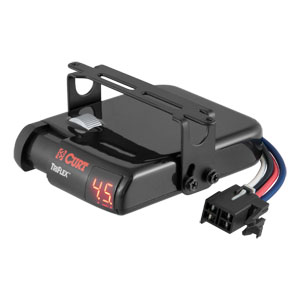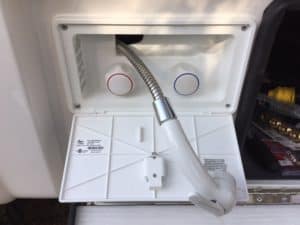Is there a demarcation between an Oliver newbie and experienced RVer? I think it’s a year. Makes sense. In that time, one can work out the kinks of the RV (and all RVs have kinks, even new ones). Plus gain experience with driving and maintenance and RV living. But here’s the thing: I am not ready to give up my title of newbie Oliver owner just yet. And it’s not just because my backing up skills are improving at a snail’s pace.
Beyond skills, there are actually things about the rig I still haven’t figured out. Okay, so maybe I should’ve titled the post More Embarrassing Admissions. Why? Because it has been a year. I look over the list and think, “How did I not make time to figure out XYZ. It couldn’t be that hard.”
Some items I really should have prioritized especially when you consider that my trailer is no longer under warranty and for all I know there might be issues. After all, my first inverter was wired wrong by Oliver, ended up frying itself (smoke and all) and needing replaced. And I would not have been in the warranty window had I discovered this today.
Other items, the necessity to learn hasn’t presented itself during the year. But that’s not a good excuse. But it is the truth. So, here is a list of 8 things I still don’t know about my RV. Not sure why, but several come in pairs.
Stereo and Television
I know how the television works. I know how the stereo works. What remains a mystery to me is how they work together. My usual method of figuring something out—poke on a lot of buttons and see what happens—has not solved the mystery.
It drives me crazy that every time I put a music CD or audiobook CD into the stereo, the television comes on. The sound comes through the television so I have to leave it on. Plus I can only control the volume by using the television remote, not the one for the stereo. To make matters worse, the sound quality on the television is terrible. Even at full volume, I cannot hear when the air condition is on.
My trailer has four black speakers throughout the tiny rig. Yep, I have surround sound. Has sound ever surrounded me? Despite a lot of button-pushing, sound only weakly comes from the television.
Well, except for that one time early on when suddenly I was surrounded by sound. No idea what I did to make it happen and never been able to replicate it.
Broken? Let’s hope not. User error? Bad button pusher? Most likely.
I complain about this, but have I pulled out the manual? No, I admit, I have not. I keep waiting for the random button pushing to net the desire results. Stay tuned. I’ll let you know if it works.
Oliver’s Outside Shower
Once I realized the outside shower offers both cold and hot water, I envisioned it as the perfect place to bathe Solstice. It’s so hard doing it in the rig’s bathroom because of how small it is and how large she is. Using Oliver’s outside shower is not as easy and straight-forward as it seems on the surface.
The problem? Drainage.
RV parks don’t appreciate soap killing their grass. And it takes a lot of soap to get a dirty dog clean. I read the rules at every new place I stay. Nearly all prohibit washing your rig at your site. They don’t expressly forbid dog bathing, but it’s clear if you can’t wash your rig that you cannot wash your pet.
That said, I have “washed” my rig with water only. I either use a hose or fill a bucket from my rig. So I could rinse Solstice if I needed to. To be honest, outside of using it for the pet, I often forget I have an outside shower.
I sure hope it works. I haven’t even turned it on a single time during the first year.
Brake Controller
The brake controller connects and controls the Oliver trailer’s brake system through the tow vehicle’s brake. I’m not sure of the technical stuff, but you plug in a cord that comes from the trailer to the tow vehicle when you are towing. Then when you need to brake, both the trailer and tow vehicle brake simultaneously. In my case, the Oliver and the van.
One time I forget to connect the cord and moved the van just a foot forward during the hooking up process and I got really scared when pressing the van’s brake did nothing. I didn’t stop. It took a couple feet—instead of a couple inches—to finally stop from a very slow roll. That’s when I truly understood the important role of the brake controller.

This is the black box mounted near my knee in the van. Mine is set at 2.0 while this one is set at 4.5.
A little box mounts inside the tow vehicle and, when hooked up, gives me a number reading each time the brake controller engages. It has to be programmed so the play between the trailer and tow vehicle is well balanced.
Three different people have programmed it for me. The first two, not very well. First, the trailer brake grabbed too hard and kind of threw the van around. Second try, the trailer wasn’t grabbing enough. Then, just like Goldilocks, the third try was just right. And I haven’t touched it since.
But here’s the thing…what if I actually had to set it or change it? I couldn’t. That’s the truth. I do have a tiny, albeit lame, justification. One day I decided it was time to figure out how the thing worked. I pulled out my brake controller paperwork to find it said nothing. It was a tiny 4” x 4” paper about the warranty.
I suspect when I bought the van and had Chevrolet install it (since it didn’t come with my van, though I have found it does come with many trucks and vans), they failed to give me the paperwork that came with the controller. Of course, in this electronic age, that’s no excuse since, no doubt, it is available online.
I recently visited some RV friends who told me every single time they hook up, they test the brake controller from their tow vehicle to their Oliver. They go a few feet and push some brake controller buttons to make the trailer stop everything just to ensure the connection is good.
I do a test of the connection, but a very different one. The other thing that connection does is make the blinker and rear braking lights work on the trailer. When I’m all hooked up and ready to go, I put my van in park, turn on a blinker then go to the back of the trailer to make sure the blinker comes on.
I assume if the blinkers work then all connections work. It actually is a safe assumption but my friend telling me about his test got me thinking I should do the same. Why? Because brakes are more important than blinkers.
That, in turn, got me thinking again about how I really need a thorough understanding of the brake controller and how to program it.
Cell Booster and WiFi Amplifier
Considering my plans to work and create blog posts from the road, it made sense for me to order both the WiFi Amplifier and Cell Booster as an add-on when I customized my Oliver.
I didn’t use either at first because I was in campgrounds where I had no problems with good strong connections. About six months in, I turned the cell booster on to see what would happen. Turns out, nothing happened. My bars were the exact same as when it was off. Where was the boost?
I emailed Oliver and was told there is actually programming involved. I have to do something to make my booster and the device (phone and computer) know the other one is there. Hmm, add that to the list of things I wish I’d been told during the orientation.
But that said, I still haven’t pulled out the manual to figure it out. I really need to. When I was I Portland recently, I thought about it again. Four miles outside a metropolitan area and I had horrible connectivity. I was quite surprised. But it shows that you never know where you’ll have connection issues.
Water Pump / Water Holding Tank
These are two features needed for boondocking. When you are hooked up to city water, the pressure from the water hose connected to the trailer is all you need for water to make its way into the rig. You don’t need the water pump.

The water pump on an RV works like this one, only a little engine (I assume) pumps the handle. Or maybe it’s little fairies who live beneath the trailer and do all the work.
But when you boondock, you go with the holding tank full of water. Then as you need water, you turn on the water pump so water from the holding tank comes out the faucet.
I turned on my water pump once early on to see how it worked. It made a terrible racket. Like so many things, I was unsure if this was normal or if something was wrong. But since I have been hooked up nearly all of my first year, I didn’t worry too much.
When I went back to Oliver for some warranty work in the spring, I asked about it. Actually, I didn’t get an answer but I did get a new water pump. When we were going over everything once they were done, I learned and heard how the new one worked.
But in the seven months since, I haven’t turned it on again. A while back I admitted that I might not be the boondocking queen I envisioned myself to be during my planning phase for an RV life. So part of the reason is purely practical. There just hasn’t been the need.
This one I hope to rectify after the New Year. I am on the west coast but need to get to Alabama to attend a conference for the month of March. I’ve been playing with the idea of boondocking my way across the country during February.
It does two things. First, it gives me the chance to use the water pump and water tank. Second, it helps me take those first steps on the road to my tiara as I become my own vision of a boondocking queen. Win-win.
Not Counting These on the Oliver
I said before that I was a little afraid of my awning. I feared opening it then not being able to get it closed again. When I was in Dubuque, my cousin opened and then closed it. I learned the trick. Keep the rod thing you use to wind and unwind the awing close to the rig. Doing so gives the awning mechanism the angle to be able to work correctly. So,in theory, I have the awning all figured out. But in reality, still a little afraid of the thing. Still haven’t opened it by myself.
Backing up the Oliver. Seriously, I just need a pass on this one. If we wait until I’m decent at backing up before I lose the newbie title, I just might be collecting social security. That said, recently I did it twice. Yes, it took many many tries. But I kept trying. Up and back. Up and back. And eventually I was in my spot. It might be without any grace whatsoever, but I did it. And I am getting better.
So, there you have it. Eight things I should know and don’t, even after a year. And two things I’m not counting. By the time I have two years of experience under my belt, let’s hope the list of eight is zero.
But let’s not bet the farm.
Links to Referenced SSL Blog Posts Above:
- Big Dog, Small Tub: Bathing Solstice in an RV Shower
- 6 Most Surprising Things About RV Life
- First 72 Hours of RV Living: Not for the Faint of Heart
To see products recently purchased by readers or to browse and shop at Amazon, follow either of these links. Huge thanks for your support.









Hey Debbie!
I might have the beginning of a solution to bathing solstice at campgrounds (once you figure out how to use your hose! ????). I have friends who do a lot of backpacking, and they use a soap that is biodegratable, water based, and made to be mild enough to use in streams. They get it at REI. I bet there is a similar product out there that could clean solstice and still not be harmful to the campground.
Thanks, Betsy. I will look into that. Good idea!
You are closer to your crown than you think … look at all the things you have learned about Quill this past year!! Have a wonderful week. Love, Marie
Debbie, You complained about the stereo sound coming through the television set.
Try this. Turn on the TV. With the TV remote, press Menu, then Audio, then TV Speakers, and set it to OFF.
If that does not work, try this. With the TV remote, press Menu, then, Setup, then AUDIO OUT, and then change from Variable to Fixed. This latter setting is so that the sound from a DVD comes out through the Stereo.
You sound like you read the manual, David. Thank you! I will definitely try it.